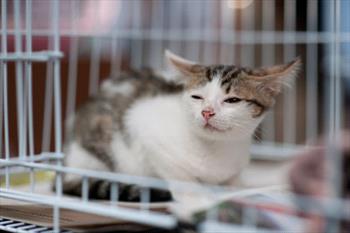Sick cat in crate

Courtesy of Depositphotos
The worst way to learn about asymptomatic carriers is by having your pet or yourself become infected. For instance, while out for a walk – didn't we all start walking more while the gym was closed? – you find a stray kitten. It's adorable and a bit scruffy, like so many kittens. Being the good person you are, you bring it home and begin to care for it. Your long-term adult cat is not thrilled at first, but soon enough the two felines are playing and sleeping together. And then you notice it: a little area of hair loss and crusting on the nose and paws of your adult cat. And maybe an itchy, inflamed lesion on your arm. After a visit to your veterinarian for both kitties and a visit to your physician for yourself, the diagnosis is made. You and your cats are infected with dermatophytosis, the fungal infection commonly called ringworm. After examination and culture, your veterinarian determines it was transmitted from the asymptomatic kitten to you and your other kitty.
An asymptomatic carrier is an animal (or person) who is infected with a disease but does not have signs of the disease. Think of the infamous Typhoid Mary, the woman who cooked for a number of families throughout a typhoid outbreak in New York in the early 1900s, causing case after case of typhoid wherever she worked. Other diseases such as HIV and tuberculosis can also be transmitted by an asymptomatic person to other people. These days, many of us have become more familiar with the concept of asymptomatic carrier because of the COVID-19 pandemic. At various points over the last two years, people who had no COVID symptoms at all were infected with the disease and, unknowingly and unintentionally, passed it along to others. That's what happened with this imaginary kitten and the ringworm.
In cats, we particularly see this issue when new pets are introduced to a household. Ringworm is one such instance, but there are others as well, whether it is a fungal, viral, or bacterial infection. For instance, it's not unusual to have an adult, vaccinated cat develop sneezing, goopy eyes, and nasal congestion after a new kitten is introduced to the home. This is often due to one of a few viruses. It's possible the adult cat was infected all along but didn't have any signs of it. The introduction of the kitten was stressful to the adult, causing mild immune suppression which allowed the virus to come out of remission, so now the adult has signs of an upper respiratory infection. But it's also possible that the kitten was an asymptomatic carrier of a viral infection to which the adult cat was susceptible. The kitten is playing happily without so much as a sniffle, but the adult is moping about the house, sneezing out … well, stuff.
And asymptomatic carriers are not limited to cats and people. Any animal could be asymptomatic for a disease contagious to others, whether of the same species or a different one. This may be what happens when you hear about a tiger or gorilla at a zoo that becomes infected with COVID-19, likely transmitted without malice from an asymptomatic zookeeper or visitor.
This is one of the main reasons that after acquiring a new pet, we recommend that it be examined by your veterinarian as soon as possible for any subtle signs of infections. It is also recommended that it be isolated from the other pets, preferably for one or two weeks. During this time, the new pet can be observed in case it is infected and changes from being an asymptomatic carrier to having signs of a disease. And of course, wash your hands after playing with the new pet, cleaning litterboxes, and so forth. This is particularly important with our reptile friends.
I imagine this discussion about isolation also sounds familiar. Maybe that is a positive takeaway from COVID-19, the education we've all had about science generally and disease transmission specifically. Hopefully people were listening and can translate the information into the care of their pets as well as themselves.